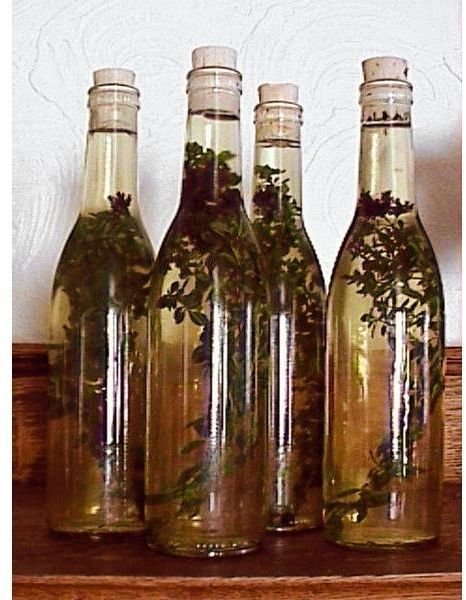How to Make Herb Vinegars: Instructions, Sample Combinations & Tips on Using
Herb vinegars are vinegars that have been made by steeping fresh or dried herbs in them. Many types of vinegars and herbs are used. Learning how to make your own is fun and easy. You can grow your own herbs or buy them locally or online (organically grown is best). Herb vinegars can be used in a variety of ways and also make wonderful gifts.
How to Make and Store
Choosing a bottle
First, you need to choose a bottle or jar to put your vinegar in. You can either buy them or you can buy cork stoppers to use on recycled wine bottles. Do not use a metal lid. All bottles/jars should be cleaned with hot, soapy water and dried completely. If any water remains in the bottle, the vinegar can become cloudy. You can also use a bottle of vinegar (just empty about 1/3 of the contents to make room for the herbs).
Choosing a vinegar
Buy a good quality vinegar. There are a variety of types you can buy and some go better with certain herbs than others. Apple cider and wine vinegars are best. It should be at least 5 percent acidity.
Choosing the herbs
Almost all herbs are used to make herbal vinegar. Popular ones include basil, fennel, rosemary, mint, lemon balm, dill, thyme, garlic and peppers. If you grow your own, gather them after the dew has dried. Gently wash and pat dry with a paper towel.
Preparing
Add the herbs to the bottle or jar (the ratio should be about 1 cup of fresh herb or 1/2 cup of dried herb to 2 cups of vinegar). Pour the vinegar over the herb, leaving about 1/2 inch of space at the top. Let it sit for 24 hours and refill with vinegar (because the herbs will soak up some of the vinegar). It is now ready to use; however, the longer it sits, the stronger the flavor becomes.
Storing
Label the bottle or jar (including the date it was made). Store in a cool, dry place at room temperature. After using, refill with vinegar to cover the herbs. Most herb vinegars will need to be replaced after six to eight months.
Sample Combinations
Apple cider
garlic, dill and bay
garlic, dill, lemon balm and mustard seeds
White wine
garlic, basil, fennel and parsley
garlic, orange mint, orange zest and coriander seeds
Red wine
garlic, rosemary, fennel, thyme, hyssop and oregano
hot red pepper, cilantro, rosemary, sage and bay
Using Herb Vinegars
Now that you know how to make herb vinegars, here are some tips on using them:
• Use in equal amounts when plain vinegar or wine are called for in a recipe, including salad dressings, marinades and sauces.
• Baste grilled meats with a mixture of 1/2 herb vinegar and 1/2 water. You can also add it to bottled BBQ sauce.
• Use it to make your own mustard.
References
What’s Cooking America: Ethel’s Guidelines For Making Herb Vinegar - https://whatscookingamerica.net/HerbVinegar.htm
Garden Guides: Herb Vinegars - https://www.gardenguides.com/1184-herb-vinegars.html
Photo courtesy of https://commons.wikimedia.org/wiki/File:Vinegar_infused_with_oregano.jpg
Disclaimer
Please read this disclaimer regarding the information contained within this article.
